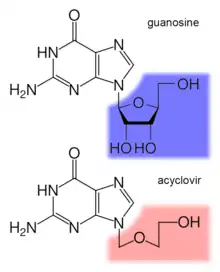Nucleoside analogue
Nucleoside analogues are nucleosides which contain a nucleic acid analogue and a sugar. Nucleotide analogs are nucleotides which contain a nucleic acid analogue, a sugar, and a phosphate group with one to three phosphates.

Nucleoside and nucleotide analogues can be used in therapeutic drugs, including a range of antiviral products used to prevent viral replication in infected cells. The most commonly used is acyclovir, although its inclusion in this category is uncertain, because it acts as a nucleoside but contains no actual sugar, as the sugar ring is replaced by an open-chain structure.
Nucleotide and nucleoside analogues can also be found naturally. Examples include ddhCTP (3ʹ-deoxy-3′,4ʹdidehydro-CTP) produced by the human antiviral protein viperin[1] and sinefungin (a S-Adenosyl methionine analogue) produced by some Streptomyces.[2]
Function
These agents can be used against hepatitis B virus, hepatitis C virus, herpes simplex, and HIV. Once they are phosphorylated, they work as antimetabolites by being similar enough to nucleotides to be incorporated into growing DNA strands; but they act as chain terminators and stop viral DNA polymerase. They are not specific to viral DNA and also affect mitochondrial DNA. Because of this they have side effects such as bone marrow suppression.
There is a large family of nucleoside analogue reverse transcriptase inhibitors, because DNA production by reverse transcriptase is very different from normal human DNA replication, so it is possible to design nucleoside analogues that are preferentially incorporated by the former. Some nucleoside analogues, however, can function both as NRTIs and polymerase inhibitors for other viruses (e.g., hepatitis B).
Less selective nucleoside analogues are used as chemotherapy agents to treat cancer, e.g. gemcitabine. They are also used as antiplatelet drugs to prevent the formation of blood clots, ticagrelor and cangrelor.
Resistance
Resistance can develop quickly with as little as one mutation.[3] Mutations occur in the enzymes that phosphorylate the drug and activate it: in the case of herpes simplex, resistance to acyclovir arises due to a mutation affecting the viral enzyme thymidine kinase. Since nucleoside analogues require two phosphorylations to be activated, one carried out by a viral enzyme and the other by enzymes in the host cell, mutations in viral thymidine kinase interfere with the first of these phosphorylations; in such cases the drug remains ineffective. There are, however, several different nucleoside analogue drugs and resistance to one of them is usually overcome by switching to another drug of the same kind (e.g. famciclovir, penciclovir, valaciclovir).
Examples
Nucleoside analogue drugs include:
- deoxyadenosine analogues:
- didanosine (ddI)(HIV)
- vidarabine (antiviral)
- adenosine analogues:
- galidesivir (Ebola)
- remdesivir (Ebola)(Marburg)(Coronavirus)
- deoxycytidine analogues:
- cytarabine (chemotherapy)
- gemcitabine (Chemotherapy)
- emtricitabine (FTC)(HIV)
- lamivudine (3TC)(HIV, hepatitis B)
- zalcitabine (ddC)(HIV)
- guanosine and deoxyguanosine analogues:
- thymidine and deoxythymidine analogues:
- stavudine (d4T)
- telbivudine (hepatitis B)
- zidovudine (azidothymidine, or AZT)(HIV)
- deoxyuridine analogues:
Related drugs are nucleobase analogs, which don't include a sugar or sugar analog, and nucleotide analogues, which also include phosphate groups.
See also
- For nucleoside analogues in biology, see nucleic acid analogues
References
- Gizzi AS, Grove TL, Arnold JJ, Jose J, Jangra RK, Garforth SJ, et al. (June 2018). "A naturally occurring antiviral ribonucleotide encoded by the human genome". Nature. Springer Science and Business Media LLC. 558 (7711): 610–614. Bibcode:2018Natur.558..610G. doi:10.1038/s41586-018-0238-4. PMC 6026066. PMID 29925952.
- Vedel, M; Lawrence, F; Robert-Gero, M; Lederer, E (14 November 1978). "The antifungal antibiotic sinefungin as a very active inhibitor of methyltransferases and of the transformation of chick embryo fibroblasts by Rous sarcoma virus". Biochemical and Biophysical Research Communications. 85 (1): 371–6. doi:10.1016/s0006-291x(78)80052-7. PMID 217377.
- "Herpes Prevention". congresouniversitariomovil.com. Retrieved 14 November 2017.